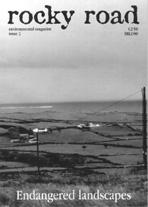|
from 12 may 2002 blue vol II, #33 |
| Feature Archive |
|
||||
|
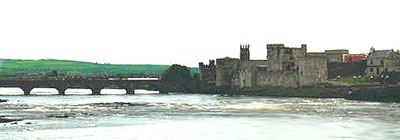
by Anne Ruimy
Somehow I had imagined an old Irish farmhouse at the end of a long winding driveway bordered by mature trees, possibly a two-storey house, so I took no notice of the two low crenelled stone-faced piers marking the entrance of the short driveway.
We eventually found Liam's house, a 1970s style bungalow partly hidden by a hedge, the entrance of the driveway marked by the two castle-style piers. We parked in the graveled area in front of the house. Around us were colourful flowers and a water feature. In front of us, over the wall bordered by low shrubs, at the foot of the green grassy hill, lay a dead cow.
Liam came out of the house behind us. "Bad day today," he said. I looked at the dead cow and then at Liam, a friendly-looking farmer in his 50s with mud on his trousers and a hole in his pullover.
"Sorry about the cow," I said. But he wasn't talking about the cow. April 12, 2002 was a bad day indeed, and a busy day. I gradually found out that, apart from organising the knackery lorry to come and take the dead cow away, thereby by-passing the futile and predictable post-mortems that always gave secondary results like pneumonia as the cause of death, Liam had to juggle the funeral of his 64 year old neighbour and family member who had just died from cancer, feed his cows in the slatted shed behind the house, and entertain the usual quota of journalists.
But it wasn't an exceptional day in what is arguably the most toxic farming environment in Ireland. It was rather a good day, pollution-wise, as the smoke from the twin smokestacks of the Aughinish factory was blowing away from Askeaton, leaving us to wonder whether the burning sensations on our face and eyes, the impulsive coughs and sneezes were just a figment of our imagination.
Liam invited us in to the kitchen and started making tea. Not the kitchen I had imagined either, no free-standing dresser and big country table with turf burning in the big open fire, but a fitted kitchen with rustic style wooden units. We sat around the kitchen table while the kettle was boiling.
For a cattle and dairy farmer close to retirement, who has lost 96 animals in the past five years, and who for over a decade has hopelessly fought the Irish government for his right to live and farm in a healthy environment, or maybe just for his more basic right to be told the truth, Liam looked in surprising good form and spirits.
These features in the immediate landscape, highly symbolic of the Somers family's anguish, were clearly visible from the window next to the kitchen table.
At the bottom of the green hill, the cow that had died the night before, supported by tyres arranged by Liam to prop her up and give her a bit of comfort as she died on her own, away from the other cows in the slatted shed who might have trampled her otherwise.
At the top of the hill, the monitoring station installed by the Irish Environmental Protection Agency in 1995 to sample air and rainwater, a station that he fought to keep running when the EPA wanted to dismantle it at the end of the two year investigation that ended up costing six million euro, took until August 2001 to get published and simply concluded that the problems were due to bad farming practices.
To the right, the newer house of his daughter Dolores, where she raises her two young children in the rare occasions when one of them at least is not hospitalised.
To the right again and half-way down the hill, a lone standing pine where a row of 15 mature pine trees once stood, the dead trees still lying there only because Liam fought the EPA's diggers who wanted to "clean up" the area and do away with this piece of vegetal evidence.
In the foreground, the parking area bounded by a few sick shrubs, their tips burnt off, giving them a broom appearance as if they had been pruned too hard and too often by a giant and ruthless gardener using acid rain for secators.
Liam poured the tea, took out sliced bread, a bag of scones and a tub of margarine, and talked about the latest significant event that happened exactly a month earlier, on March 11, 2002.
That night, an incident following a power cut in the Aughinish Alumina factory across the Shannon had resulted in a caustic blow-out. In the morning Liam had noticed that all the shiny surfaces outside - his and his daugther's car, the bales of silage wrapped in black plastic - were covered in little pinkish white dots. The pink hue was reminiscent of the pink lining of the white sulfur dioxide-laden smoke plumes coming out of the twin smokestacks of the Aughinish Alumina factory, and of the red mud dumped on the factory site that is the waste product of the refinement of alumina from bauxite.
"It was the first time I could pin it down to a day," Liam explained. "I reported it. I called the EPA, asked if they had any other report. No, they hadn't. They came within an hour, took samples from my car, my daughter's car, herbage samples."
If past history is anything to go by, even if this event was defined in time and clearly attributable to one amongst the many industries that line the Shannon Estuary, the EPA and other governmental agencies would never admit that Liam's and his neighbours' animal health problems, or the unusually high cancer rate in the area, are caused by industrial pollution from an EPA-licensed factory.
Liam was talking incessantly, pausing occasionally to ask me if I wanted to know something in particular. I kept answering that I just wanted an update of the most recent events in Askeaton.
His memory was accurate, he insisted, and just to be sure he was keeping records of everything, from fertilizer bills to newspaper clippings. "I've a calendar up the wall. Any day there'd be a fallout or a plume running along the ground, the first job I'd do when I'd come in, I'd mark it out."
The March 11 blow-out.
The day, years ago, when the milk lorry from the Golden Vale co-op didn't stop at his farm to collect his milk, and most of his neighbours gave up the fight.
December 23, 1995, when the EPA brought cows from Dublin to his farm at the start of the two-year investigation during which they ran his farm with the latest farming technologies and limitless amounts of taxpayers money but ended up with the same problems of stillbirths, infertility and disease.
We had been talking for about an hour, and we had been interrupted a couple of times by neighbours and family members. This time it was Dolores who popped in to the kitchen with an enquiry relating to the funeral. As Liam introduced us, she asked what my slant on this story was. I explained that being a journalist writing on environmental issues, if I have a slant it is pro-nature.
She appeared relieved, and Liam went on to explain that people disguised as journalists have been crossing his fields and taking photographs, and others, real journalists, interviewed him then turned around and wrote "anti-farmer, pro-industry" articles.
Liam recounted how he has answered every request from every journalist, entertained school trips to his farm incessantly since the cattle deaths and ill-health started on his and his neighbour Justin Ryan's farms in the late 1980s and early 1990s. In 1992, when the problems where at their worst, he was dealing with four or five organisations per day.
Liam is a patient man, but he doesn't have patience for the anti-farmer, pro-industry visitors. And over the years he has devised a strategy to deal with them: the journalists who write negative pieces won't get a second interview, and the spies from the Aughinish Alumina factory, the apparent source of his troubles, are chased away. "There'd be insurance problems if one of them got hurt," he hinted.
"I'm lucky, I'm healthy" Liam said, touching wood, after she left. "The only thing with myself is the throat, the constant cough." He looked healthy too, apart from the extremely dry skin on his face and hands. He didn't seem depressed by the apparently hopeless, decades-long battle against the EPA and the "government" in general - the "pro-industry" types. He smiled often. After all these years he seemed almost detached from the events affecting him, his family and his neighbours.
"My family is getting tired of this," he acknowledged. "I'm in dairying, it's time consuming. They say: why don't you open a pub, you could stay talking all day."
If anything, it wasn't the fight he was going to give up but the farm work, to focus on organising and filing the room full of documents he had collected over the years. Why did he feel that it was his duty to keep on fighting, I asked. Was there any hope for him and his family?
He responded that he was clinging on to the hope that "somebody, somewhere, someday will come, not influenced by government," who will take the decisive sample, make the conclusive test, identify the exact chemical that causes "lumps from the size of a finger nail to the size of a football" to break out of his cows' hides, and trace this pollutant to the number one suspect factory: Aughinish Alumina.
We went outside for the customary tour of the farm. It was a mostly dry, cloudy day with sunny spells. Liam first took us up the grassy hill, the one we could see from the kitchen window, to show us the stunning views over green fields to the Shannon estuary dotted with factories: the Wyeth baby food factory the closest, then Aughinish Alumina, and beyond that Tarbert oil-fired power station, the three almost lined up and up-wind from with his farm for maximum impact. Also visible were Shannon Airport with its oil tanks, and on the other side of the water in County Clare lay Moneypoint coal-fired power station and Roche with its hazardous waste incinerator.
We strolled back down the hill, a natural meadow dotted with some wildflowers, to take a closer look at the intensively managed grazing paddocks where Liam wanted to show us visible evidence of plant damage. He pointed at the multi-coloured grass showing different stages of disease, from purple to red to brown, then finally dying off.
Even though the paddocks all receive an homogeneous fertilizing treatment following the prescriptions from the national farm advisory body Teagasc, supplemented with trace elements to correct imbalances detected by the latest mineral tests undertaken, grass growth and appearance were patchy.
The Charolais cows grazing some of the paddocks in rotation looked mostly well, except for one, the mother of a week-old brown bull calf "the size of a sheep dog" who was hiding in the tall grass. The mother cow was thin, with an odd asymmetric appearance, her ears hanging down, showing the same symptoms than the dead cow lying in front of the bungalow had shown.
I asked him if he could stand near the calf for a photo. He started chasing away the little calf towards the camera, across the tall grass, containing an almost joyful laugh. The photos had to reflect the fact that the situation was more tragic than comic.
"It's some environment to be living in," Liam said as we walked back towards the house. The knackery truck had just arrived into the yard and he had to get busy.
The last soundbite sounded like it had been used before. We drove home. After a few hours, the burning sensation on our eyes and faces started to ease, but it took a few days for the automatic coughs to stop.
The Askeaton Tragedy, Part One by Robert Allen and Anne Ruimy
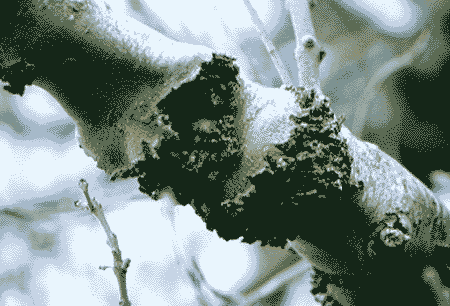
North west Limerick, a stone's throw from the Shannon estuary, is to the innocent traveller a place of quiet beauty and reserved solitude. Beef and dairy cattle are abundant on fields of luscious greenery. It's a scene common in the brochures of Bord Failte (Irish Tourist Board). A glimpse of a time when the production of food was essential to the well-being of Irish communities, this seemingly rural setting is a false one, for beyond the fields on the western horizon the idyll is shattered by the smokestacks of industry and modern commerce. The nearest are that of Aughinish Alumina, where the refinement of alumina from bauxite results in the emission of 17,000 tonnes a year of sulphur dioxide. Beyond Aughinish further along the estuary lies Tarbert oil-fired power generating station and Moneypoint coal-fired station whose particulate emissions darken the sky. These industries spew thousands of tonnes of chemicals and heavy metals into the Clare and Limerick air, which eventually fall onto fields and farms as acid rain and are taken up by plants and animals. Sometime during the late 80s this deadly cocktail of pollutants, augmented by pollution streams from the European mainland, began to change the lives of the local farmers, resulting in the deaths of approximately 330 animals, general ill health among animals on many farms and the beginning of an awareness that the illnesses people were dying from were somehow related to these toxic fumes. "Given the scale of emissions from industries in the Shannon estuary it would be surprising if there were no ill effects or manifestations of pollution in the region," scientist Rory Finegan lamented in the conclusion of his investigation into the vegetational and animal health problems on the 59 acre farm of Liam Somers at Issane near the ancient, monastery town of Askeaton in west Limerick. As the animals died in their hundreds, farming families around the Askeaton and Ballysteen areas felt powerless - particularly those of Liam Somers and Justin Ryan who between them had lost roughly 200 animals and watched their neighbours succumb to all manner of unusual diseases. Not only were they at the mercy of the state's obfuscations and industry's propaganda, they appeared unable to challenge the hierarchical systems which had disempowered them. In the midst of their despair and frustration they had become dependent on bureaucrats, scientists, politicians, journalists and environmentalists in the hope that these elites would somehow represent their plight to the wider community. And that someone would actually do something positive when, inevitably they naively assumed, the cause of the problems were revealed. This rested on a false belief that a solution acceptable to everyone implicated in this ecological soap opera would be discovered. Consequently, as the government procrastinated and bureaucrats deliberated, the farmers realised fairly quickly that their interests were secondary to local industry, Limerick County Council, the Electricity Supply Board (ESB - which operate the power stations) and the Irish state. That the farmers' animals had been poisoned, their own health (and that of their neighbours) impaired and their livelihoods destroyed appeared to be of concern to all these pocket hierarchies. Yet, they feared, it would come to nothing. The state, it seemed, had no intention of launching an investigation. "The Agency is not going to be a fire brigade for anyone," the EPA's Iain Mclean told the Cork Environmental Alliance (CEA) when asked if they would investigate.
Yet despite this wider concern, from the state, industry, the media, the organised greens and individual activists, no one made an attempt to integrate the ecological, agricultural, social and political implications of the agricultural and industrial pollution in west Limerick into a holistic framework. By 1995, when the EPA finally took action and launched an investigation which they announced would solve the mystery into the animal deaths and the ill health in animals all over the district, there was a genuine fear that nothing would be resolved. The conclusions of the EPA's initial IR£1million (US$2m) investigation would rest solely on science and would not involve the social, political and economic subtexts. But it would only be their science that counted. Independent studies would simply contribute to the scientific confusion in the minds of the public. Those who in a different era would have been able to explain the other perspectives do not have the resources or the will. The establishment media in Ireland no longer encourages investigative journalism that does not involve tip-offs or leaks. The green movement either lacks both resources and willpower. Those political parties who should be making an issue of the pollution and animal health problems in west Limerick do not have the expertise. The EPA's agenda became apparent when its three interim reports were published in September 1995, April 1997 and August 1998. Unfortunately for the farmers the investigation was retrospective. "It is clear," the authors of the second report state, "that whatever adverse circumstances led to the cattle deaths and ill-health on Ryan's and Somers' farms in the late 1980s and early 1990s are now absent." The reason for the state's inability to address these issues holistically is both complex and simple. We live in a world which is dominated by the culture of consumerism; to survive we must enter the buyer-seller nexus. Social ecologist Murray Bookchin has described this to include every aspect of production, consumption, community life and family. "Our agricultural epoch - a distinctively capitalist one - envisions food cultivation as a business enterprise to be operated strictly for the purpose of generating profit in a market economy." In west Limerick one method of profit making conflicted with a competitive and more lucrative method. Although the farmers around Askeaton practised industrial agriculture for the benefit of the national economy, they were unwittingly up against a global hierarchy - in the form of the chemical industry. The fact that food - milk in the case of the Limerick farmers - is a commodity in much the same way that aluminium is matters little here. Aluminium benefits the global economy, milk doesn't. If the milk should happen to become contaminated, the obvious course of action is to pretend there isn't a real problem, otherwise people would be wary of buying the product. Both the national and the global economies needed to be protected. Hence an unmarked co-op milk lorry was seen at the farms of Somers and Ryan to collect the allegedly contaminated milk before both farmers were forced to accept deals from the state. The co-op - Golden Vale in this instance - paid the two farmers roughly ten pence less than the going rate for their milk which was taken off into the distance. What became of it you ask? That's a question Golden Vale would be best placed to answer. They claimed to have tested the milk and found nothing wrong with it, so why the unmarked lorries and the lower price to the farmers? Notwithstanding the spectre of pollution hanging over the land this was a fine solution, albeit a cursory one, for the farmers because the product must be maintained otherwise livelihoods and profits would be damaged. And while the farmers would become emotional in their cries about the aluminium factory, the state had to find a solution that would not drive the corporate out of the country while assuaging the fears of those would had been affected by the mystery illnesses.
Farmers with generational knowledge of their land do not become bad farmers overnight no more than people suddenly become ill without cause. "Every farmer around here has bad problems," one farmer said in 1995, aware that until 1995 there hadn't been a genuine attempt to record exactly what the animal and human health problems were. The animal health problems identified on the farms of the affected farmers were seen by the majority of local farmers as the extreme end of the problem. The Askeaton, Ballysteen Animal Health Committee, when it was set up by the farmers in May 1994 to investigate "the situation as far as possible" didn't have the funds to commission the kind of independent analysis which, augmented by the rich local knowledge of the people who live in west Limerick, would have conclusively revealed the extent of the pollution. Significantly none of the regulatory authorities have been able to characterise all the local pollution, particularly atmospheric pollution, and as the wind patterns are variable this pollution has been widespread. A westerly carries most of the pollution over the farms of Somers and Ryan but their problems appeared to be unique. The reason for that would surely baffle any authority that did not wish to learn the truth. And there is no evidence from the investigation that the state has ever wanted to provide answers to the farmers, other than to prove that everything is okay now. Dr. Paul Toner of the EPA was adamant in 1995 that until proven otherwise the existing pollution in the area is within safe levels, though he admitted that the overall problem could be quite complex. Several scientists, notably Finegan, called in 1995 for more detailed information on the industrial processes to the west of the affected areas, vis Aughinish and the two power stations. Conversely Finegan was adamant that "sick plants and sick animals" are a sufficient enough indication that "environmental pollution is occurring". There is, he said in 1995, "a superimposition of pollutants" in the area. Yet Aughinish were able, in all innocence it seemed, to state they are not and never have been the source of the farmers' problems - their publicist Frank Dunlop rallying at the hearing into his company's integrated pollution licence (during the summer of 1997) that accusations against his company were unfounded.
There is or was an animal health problem but no one appeared to know what to do. As research scientist Peter Montague put it in 1996 "regulators and judges now insist that science has to 'prove harm' before regulatory control can begin". Those who study science know that science cannot categorically "prove" anything. "It often takes science decades - sometimes centuries - to reach a clear majority opinion and there will always be uncertainties, giving rise to nagging doubts which can only be laid to rest by further study," Montague wrote in relation to the proof that science has provided for human injury without subsequent action by the regulatory authorities. The EPA's investigation may be seen as a serious attempt to address the farmers' problems but it remains to be seen whether they have the political will to deal with these problems, no matter how complex they seem to be. So when air pollution scientists Paul and Valerie Dowding highlighted the role of modern farming practice - which afterall is encouraged by the state on behalf on industry - they simply isolated the issue, obscuring the overall or holistic viewpoint. Industrial agriculture (the use of pesticides, artificial fertilisers, genetic hormones, antibiotics and other chemicals) exacerbates the problems caused by intensive farming, thus depleting the soil of natural minerals. Many of the affected farmers practice industrial agriculture. Coupled with industrial atmospheric pollution, the land of the affected farmers isn't capable of maintaining animals which depend on the richness of the soil for their well-being. Thus already stressed animals have further burdens to contend with. Mineral deficiency appears to be a major cause of the farmers' problems. The early 1990s coalition government of Fine Gael /Labour/Democratic Left had urged the senior civil servants in the departments of Health, Environment and Agriculture to take seriously the farmers' problems. Yet before the investigation began in earnest the government agencies involved were telling the media there wasn't a problem. The Mid-Western Health Board made it clear that it believed there were no human health problems associated with industrial pollution in west Limerick, contradicting the local knowledge that a high number of people suffered from a range of illnesses. The Health Board's epidemiological study and long term monitoring programme of human health in the Shannon estuary area has unsurprisingly revealed nothing so far - but critics of the study have pointed out that their methodology is flawed, inadequate and therefore unlikely to find anything. Something is causing people to die of cancer and no one in authority appears to know what it is. The cluster of cancers in the area are, apparently, not unusual - a statement local people find hard to believe. The EPA, which co-ordinated the investigation in conjunction with Teagasc (the agricultural advisory board), the Mid-Western Health Board and the Veterinary Research Laboratory, has been publishing weighty tomes which look impressive but reveal nothing of substance. The investigation was set up to include a study of animal health on the affected farms (using a control group of animals from an unpolluted farm), an analysis of the animals' immune systems and a general study of all animal health in the area; sampling of soil, herbage, vegetation, animal feed, drinking water and milk; and atmospheric emissions. The samples were tested for minerals, heavy metals, organic and inorganic chemicals, including polyaromatic hydrocarbons, PCBs and dioxins. "If it is industrial pollution we will attempt to prevent that pollution," said Dr. Toner of the EPA in 1995. "We are the regulatory authority and we will take action." As the investigation got under way the most affected farmers, Somers and Ryan, had to consider their plight. Both were asked to participate in the animal health study by Teagasc at their farms. Somers turned down three offers from the state to supplement his income as part of the study before finally agreeing to sell his herd of 93 cattle for a sum believed to be in the region of £80,000. Shortly afterwards, in January 1996, he said he believed that the investigators would say their analysis of his cattle and soil has revealed nothing. "Telling us that they've found nothing is ridiculous after 96 animals dead," and so far Somers has been proved right. While the investigation was going on the government provided Somers with an income. "We've enough to eat and it's keeping us off the dole," he sighed discontentedly a few months after the first interim report was published in September 1995. "They are letting us have an income and we're letting them into the farm on goodwill. Otherwise I'd stand and fight a bit longer and get them to cough up for the dead animals. We've lost about £200,000 in dead animals, loss of milk quota and the benefits upgrading the farm would have brought over the past seven years. The EU want to bring up the standards in milk parlours, which brings farmers who meet those standards an extra three pence a gallon."
"I don't think we're ever going to get any answers with this investigation," Somers said in July 1997. "The cattle are fair, but they can't say they are fine. Only about six out of the 28 are milking fair and they've no explanation for it. The ones that don't do well, they cull. Their milk yield is so low. They say they are doing 1000 gallons a cow but they are just milking away until they get a yield.
"That's not viable farming. You don't feed cattle 365 days of the year and then milk them 365 days just to get a 1000 gallon quota. They've been feeding them up to 19 pounds a day concentrate - a 18 percent protein mix. I usually do 10 pounds a day of a 16 percent protein. Normally I would feed them concentrate from February through to April but they've been feeding them concentrate throughout the winter, along with the silage from the farm, until June there. They want to feed them concentrate all the time. I would milk cattle for between 260 and 280 days and give them a two month dry period before calving. And get between 850 and 900 gallons per cow a year. It wouldn't be farming on a small farm to be doing what they are doing. They don't seem to mind about the cost. No ordinary farmer could afford to run a farm like that. I would spend between two and three thousand and a year on concentrate and they must be spending double that. They'd nil profit for 1996. The whole investigation is a terrible waste of money and nothing coming out of it." The farmers believe they know who the catalyst is, why they are having problems of this kind; they know their land and they have eyes. They also have ears and believe that Somers and Ryan had no choice but to accept the government's financial packages to save their livelihoods. The Ryans choose a new life in Tipperary. "Justin and I have had to leave our farm and our families in order to give our children a future because there is none left on the poisoned farm," Suzanne Ryan wrote in a letter to the Cork Environmental Alliance. "We also know that the finger will never be pointed at the source of the problem." But Suzanne was wrong about that. In the winter of 1998 the finger was pointed and many people believe it was pointed in the right direction. The finger-pointers were the Irish Equine Centre. Their independent study found aluminium at levels liable to cause death in animals and serious ill health in humans. This appeared to be the proof that was needed but the EPA were adamant that "there is no significant pollution in the area". The farmers sighed and shook their heads. The EPA, raged Simon White - one of the affected farmers and the Irish Farmers Association's representative in the area - is "more concerned with protecting industrial operations than they are in protecting the environment". White's frustration at the EPA's insistence that there is "no evidence of aluminium toxicity" in the area was an accurate reflection of the mood among the affected farmers and the local community. Now it appears that this latest ecological soap-opera may be played out in the courts. An IFA funded independent study is expected to give White the research information the farmers need to question the EPA's methods. The Cork Environmental Alliance's warning, after the Hanrahan family's successful prosecution of Merck Sharp and Dohme for alleged chemical pollution in the 70s and 80s, that this kind of toxic tragedy should never be allowed to happen again has been ignored. "From the very beginning this investigation was seen by many as little more than a 'cover-up' designed simply as a damage limitation exercise to protect state industrial policy in the Shannon Estuary," the CEA's Derry Chambers said in October 1998. "There can be no other logical reason for the incompetence displayed in the investigation procedure."
In his organisation's occasional magazine Chambers put it another way. "Most people are shocked when they hear about events on the Shannon Estuary, Yet there is no real mystery or Machiavellian cover-up of events there, for the simple truth that there was never any need. And therein lies the real tragedy for our society. In Ireland too few people cared or had the integrity to cry halt when animals began to be poisoned at Askeaton.
"As in the past, in Cork Harbour or Ballydine, we as a society willingly choose to accept the official version of what was happening.
"We choose to believe that industrial emissions were not the cause, that the farmers involved were lazy combo chasing bastards, that the state was determined to find the cause, that the best scientific principles were employed in the investigation, etc, etc.
"We choose to believe anything that would not upset our cosy view of ourselves as a good natured, caring and just society."
|
||||

 I was reading the directions scribbled on a piece of paper: "Take the second little road off the Askeaton by-pass, not the road leading to Wyeth baby food factory, the one before that. Go straight on, towards Ballysteen, until you see two round stone piers on the right, the entrance to the house. The house is not visible from the road." Carsten the photographer was driving and we had missed Liam Somers' house.
I was reading the directions scribbled on a piece of paper: "Take the second little road off the Askeaton by-pass, not the road leading to Wyeth baby food factory, the one before that. Go straight on, towards Ballysteen, until you see two round stone piers on the right, the entrance to the house. The house is not visible from the road." Carsten the photographer was driving and we had missed Liam Somers' house.
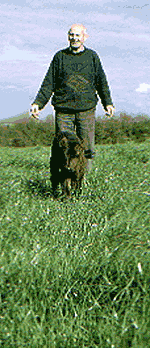 I had come to interview him about the mysterious and controversial cluster of animal, plant and human health problems in this small corner of north west Limerick, south of the river Shannon in the west of Ireland. He talked at length about the recent events on his farm, occasionally interrupting the flow of his vivid account to point out one of the features laid out on the hill in front of his bungalow as if they were visual aids to illustrate his story.
I had come to interview him about the mysterious and controversial cluster of animal, plant and human health problems in this small corner of north west Limerick, south of the river Shannon in the west of Ireland. He talked at length about the recent events on his farm, occasionally interrupting the flow of his vivid account to point out one of the features laid out on the hill in front of his bungalow as if they were visual aids to illustrate his story.
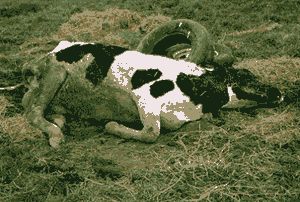 The story made headlines this time and the factory admitted to the pollution, though a spokesman denied that the incident had caused any problem outside the plant.
The story made headlines this time and the factory admitted to the pollution, though a spokesman denied that the incident had caused any problem outside the plant.
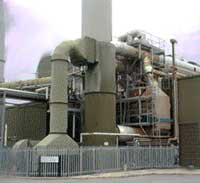 "Tell her about your children," Liam said to his daughter. Dolores obliged. She told me how her two children have had health problems since they were born. As we were speaking one of them was in Limerick Hospital with coxsackie virus (or human hand, foot and mouth disease). Both had intolerance to cow milk based baby formula. The first one managed with a soy-based formula, but the "smaller fellow" was intolerant even to that, she explained. Supreme irony, the anti-allergy formula she feeds her baby with is produced by Wyeth, the closest factory to their home that is probably contributing to their ill health.
"Tell her about your children," Liam said to his daughter. Dolores obliged. She told me how her two children have had health problems since they were born. As we were speaking one of them was in Limerick Hospital with coxsackie virus (or human hand, foot and mouth disease). Both had intolerance to cow milk based baby formula. The first one managed with a soy-based formula, but the "smaller fellow" was intolerant even to that, she explained. Supreme irony, the anti-allergy formula she feeds her baby with is produced by Wyeth, the closest factory to their home that is probably contributing to their ill health.
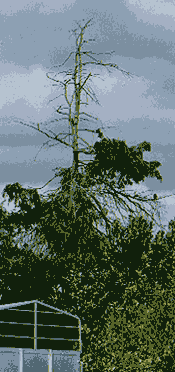 Still, Ireland's primary green groups, the CEA, Earthwatch and Greenpeace (now Voice of Irish Concern for the Environment -VOICE) all highlighted the animal health problems in west Limerick and took the farmers' case to higher authorities. The Green Party pledged its support to the farmers. TD Trevor Sargent toured from his Dublin constituency to see Somers. The Limerick and Cork print and electronic media dutifully reported the 'story' from most of the respective angles. Those who gain their news from the national (Dublin) media were told of events in west Limerick. Although generally quiet about pollution from the Shannon estuary several politicians, including the odd minister or two, expressed their concern. Many individuals supported the farmers' genuine claims.
Still, Ireland's primary green groups, the CEA, Earthwatch and Greenpeace (now Voice of Irish Concern for the Environment -VOICE) all highlighted the animal health problems in west Limerick and took the farmers' case to higher authorities. The Green Party pledged its support to the farmers. TD Trevor Sargent toured from his Dublin constituency to see Somers. The Limerick and Cork print and electronic media dutifully reported the 'story' from most of the respective angles. Those who gain their news from the national (Dublin) media were told of events in west Limerick. Although generally quiet about pollution from the Shannon estuary several politicians, including the odd minister or two, expressed their concern. Many individuals supported the farmers' genuine claims.
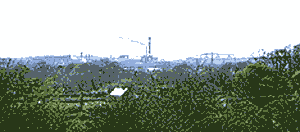 According to Somers the arrival of the unmarked milk lorry quieted concern among the farmers. Meanwhile, behind closed doors, the cogs of government were maintained and the wheels of commerce rolled on. Industry went about the business of improving its image, not forgetting to stress the importance of their continued existence to the local economies. Yet the problems of pollution and ill health remained. No one in authority thought to genuinely consider the potential catalyst for the farmers' problems - arguably because they did not have to. The legislation governing integrated pollution licences would take care of that - when the time came. In western industrial society, diplomatic solutions are found for the problems of pollution - behind closed doors.
According to Somers the arrival of the unmarked milk lorry quieted concern among the farmers. Meanwhile, behind closed doors, the cogs of government were maintained and the wheels of commerce rolled on. Industry went about the business of improving its image, not forgetting to stress the importance of their continued existence to the local economies. Yet the problems of pollution and ill health remained. No one in authority thought to genuinely consider the potential catalyst for the farmers' problems - arguably because they did not have to. The legislation governing integrated pollution licences would take care of that - when the time came. In western industrial society, diplomatic solutions are found for the problems of pollution - behind closed doors.
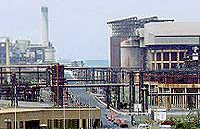 But, as Finegan said, there is no comprehensive information on the effects on people, animals, wild and plant life from the pollution in west Limerick, irrespective of the sources. Aughinish know it is not legally possible to claim that any one pollutant is responsible for any one illness, whether in animals or humans, and that is their defence. Instead of the onus being on Aughinish to prove that they aren't responsible, whether as the primary source or as part of an aggregate of sources, the farmers must prove that they are and for the moment the law and science are not geared towards that eventuality. That however is not the point here.
But, as Finegan said, there is no comprehensive information on the effects on people, animals, wild and plant life from the pollution in west Limerick, irrespective of the sources. Aughinish know it is not legally possible to claim that any one pollutant is responsible for any one illness, whether in animals or humans, and that is their defence. Instead of the onus being on Aughinish to prove that they aren't responsible, whether as the primary source or as part of an aggregate of sources, the farmers must prove that they are and for the moment the law and science are not geared towards that eventuality. That however is not the point here.
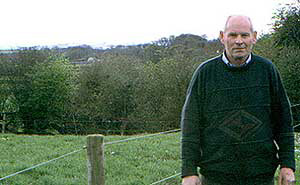 Interestingly it is the belief of Somers and several other Askeaton farmers that the government is admitting that the problem has not been caused by the farmers. Which makes them wonder who has. But they added cautiously they can't see the government doing anything significant about industrial pollution in the area. Following a meeting in September 1995 to discover how many farmers have animal health problems, it was learned that the government had told farmers they could have confidentiality if they wanted to join the investigation. Some 20 farmers took up this offer, but Justin Ryan sold his farm (adjacent to Weyth, a baby food factory) to the government for a package believed to be worth £367,000. Somers believed Ryan had no choice but he said he could not do the same. "If I can't live on my farm, the fella next door can't live on it either. They have to sort it out. This is my family farm and I can't leave." (The farm has been in the Somers family for over three generations.)
Interestingly it is the belief of Somers and several other Askeaton farmers that the government is admitting that the problem has not been caused by the farmers. Which makes them wonder who has. But they added cautiously they can't see the government doing anything significant about industrial pollution in the area. Following a meeting in September 1995 to discover how many farmers have animal health problems, it was learned that the government had told farmers they could have confidentiality if they wanted to join the investigation. Some 20 farmers took up this offer, but Justin Ryan sold his farm (adjacent to Weyth, a baby food factory) to the government for a package believed to be worth £367,000. Somers believed Ryan had no choice but he said he could not do the same. "If I can't live on my farm, the fella next door can't live on it either. They have to sort it out. This is my family farm and I can't leave." (The farm has been in the Somers family for over three generations.)
